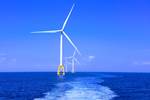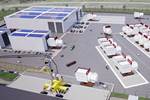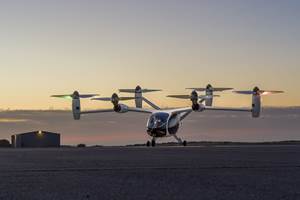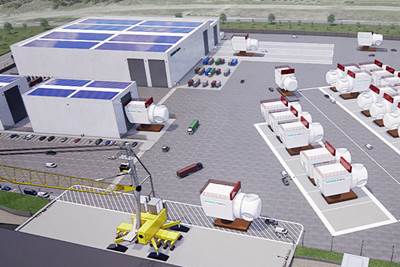Intelligence report suggests US offshore wind is gaining momentum
Clarksons Research’s updated report proposes offshore wind in the U.S. will play a vital role in the energy transition despite challenges, with potential for 23 GW and 1,600 turbines by 2030.
Clarksons Research (London, U.K.), a data and intelligence company for shipping, trade, offshore and the maritime energy transition, has released a new report on its Renewables Intelligence Network (RIN) platform. This report profiles the offshore wind sector in the U.S., including a capacity forecast out to 2030, analysis of the fleet of vessels set to serve the growing U.S. sector and coverage of recent federal government policies. Reviewing the data, Steve Gordon, managing director of Clarksons Research, provides additional insight.
Gordon notes that the U.S. offshore wind sector has gained momentum in recent years and appears likely to emerge as a key growth region for the global offshore wind industry, although challenges around the Jones Act and offshore wind supply chain are present. Clarksons projects installed capacity off the U.S. to reach 23 gigawatts (GW) by 2030 across 29 wind farms and approximately 1,600 turbines, up from just 42 megawatts (MW) today (two wind farms and seven turbines).
More than 45 GW of offshore wind capacity have been proposed by developers off of the U.S., with 39 GW having been raised off the U.S. East Coast, including 11 GW off New York and 9.2 GW off New Jersey. Off of the U.S. West Coast, floating foundations will be required, with five floating wind lease areas off California awarded to developers in December 2022.
Moreover, the current U.S. administration has taken steps to accelerate the build-out of offshore wind in the U.S. as it aims for 30 GW of installed capacity by 2030, including a streamlining of the permitting process. Furthermore, the Inflation Reduction Act aims to support investment in offshore wind projects and the supply chain by providing tax credits for developers, equipment manufacturers and shipyards.
On a global level, Clarksons’ long-term scenarios suggest offshore wind will play a vital role in the energy transition.
Capacity growth in the U.S. is likely to be led by domestic utilities such as Avangrid Renewables (Portland, Ore., U.S.) — 5.9 GW of proposed capacity by ownership share — and international developers such as Ørsted (Fredericia, Denmark) — 5.1 GW of proposed capacity. However, high inflation and rising interest rates are exerting cost pressures on developers and could result in timeline slippage for certain projects.
The U.S. wind “fleet” currently comprises 25 vessels and primarily includes oil and gas assets marketed for wind work. An additional 25 U.S. owned and built wind vessels are on order, including 19 crew transfer vessels (CTVs) and three service operation vessels (SOVs), although only on wind turbine installation vessel (WTIV) is currently being built in the U.S. (Charybdis). U.S. shipyard capacity and capability for building WTIVs is said to have limitations, and vessel owners in the U.S. also face competition for yard space from the military and a significant price premium, presenting a potential bottleneck for the build out of offshore wind capacity in the U.S.
Developers of the first wave of projects in the U.S. are likely to use European WTIVs to install turbines, with Jones Act feeder barges set to transport turbine components from U.S. ports to the wind farms. For instance, Maersk Supply Service (Rio de Janeiro, Brazil) will provide its WTIV (currently being built in Singapore) to install the turbines at Equinor’s (Stavanger, Norway) Empire Wind project, with Kirby Offshore (Staten Island, N.Y., U.S.) to supply U.S.-built feeder barges.
According to Gordon, the U.S. offshore wind supply chain is currently immature and is likely to require significant investment and expansion to support future growth of offshore wind capacity. A number of turbine staging areas along the U.S. East Coast have been proposed, while fabricators such as Siemens Gamesa, EEW and Prysmian have all announced plans to build manufacturing plants in the U.S.
On a global level, Clarksons’ long-term scenarios suggest offshore wind will play a vital role in the energy transition, potentially providing between 7% and 9% of global energy supply by 2050. Globally, projections suggest approximately 250 GW of active capacity and 30,000 active turbines by 2030 — currently there is 62 GW and approximately 12,400 turbines.
For more reports on the direction of U.S. offshore wind, read Renewable Consulting Groups’ report and American Clean Power’s report.
Related Content
Polar Technology develops innovative solutions for hydrogen storage
Conformable “Hydrogen in a Box” prototype for compressed gas storage has been tested to 350 and 700 bar, liquid hydrogen storage is being evaluated.
Read MoreJEC World 2023 highlights: Recyclable resins, renewable energy solutions, award-winning automotive
CW technical editor Hannah Mason recaps some of the technology on display at JEC World, including natural, bio-based or recyclable materials solutions, innovative automotive and renewable energy components and more.
Read MoreHow composites have become a necessity
Composites used to be one of many material options across industries and applications, but that's not the case anymore.
Read MoreRTM, dry braided fabric enable faster, cost-effective manufacture for hydrokinetic turbine components
Switching from prepreg to RTM led to significant time and cost savings for the manufacture of fiberglass struts and complex carbon fiber composite foils that power ORPC’s RivGen systems.
Read MoreRead Next
U.S. DOE strategy to accelerate, expand domestic offshore wind
Newly released, department-wide strategy will tap the United States’ vast potential of offshore wind energy deployment to meet 30 GW goal by 2030.
Read MoreSiemens Gamesa to establish offshore wind turbine nacelle facility in New York
Second U.S. facility and several new supplier facilities are intended to build economic, employment and environmental sustainability in the U.S.
Read MoreAll-recycled, needle-punched nonwoven CFRP slashes carbon footprint of Formula 2 seat
Dallara and Tenowo collaborate to produce a race-ready Formula 2 seat using recycled carbon fiber, reducing CO2 emissions by 97.5% compared to virgin materials.
Read More

























